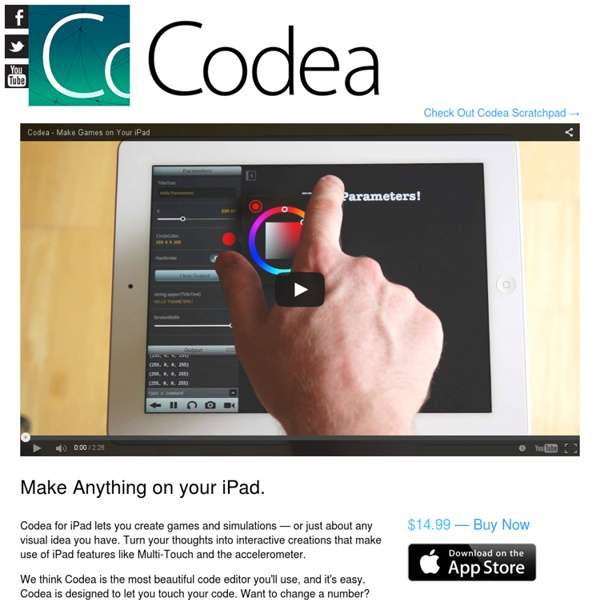



http://twolivesleft.com/Codea/
Related: CodeCargo-Bot – iPad The first game programmed entirely on iPad® Be Logical. Play Cargo-Bot Presenting Cargo-Bot. OpenClassroom Full courses. Short Videos. Free for everyone. Learn the fundamentals of human-computer interaction and design thinking, with an emphasis on mobile web applications. A practical introduction to Unix and command line utilities with a focus on Linux. Functional Reactive Programming Functional Reactive Programming (FRP) integrates time flow and compositional events into functional programming. This provides an elegant way to express computation in domains such as interactive animations, robotics, computer vision, user interfaces, and simulation. 1 Introduction The original formulation of Functional Reactive Programming can be found in the ICFP 97 paper Functional Reactive Animation by Conal Elliott and Paul Hudak.
New Bee-Bot App I've always been a fan of using the Bee-Bot to help teach control programming skills in the EYFS - see this blog post. As children get older and want to make it travel along more complex routes however, I've often found that they can get a little impatient waiting for their turn. To address this issue, our Year 1 children are therefore taught how to program the on-screen version of the Bee-Bot using a program on the computers called Focus on Bee-Bot - see this article I wrote about it a couple of years ago. Kodu Kodu is a new visual programming language made specifically for creating games. It is designed to be accessible for children and enjoyable for anyone. The programming environment runs on the Xbox, allowing rapid design iteration using only a game controller for input. Programming as a Creative Medium The core of the Kodu project is the programming user interface. The language is simple and entirely icon-based.
Kids must code on iPads An important 21st Century skill This post is about a topic and app close to my heart. Computer programming is the engine of modern life and dream maker for tens of thousands. More and more countries are introducing the subject as compulsory schooling at surprisingly young ages. The UK is introducing a national school programme in september this year whilst also funding yearofcode.org to increase momentum. Code.org is pushing an international message with big-name endorsement.
Building Dynamic Websites / OpenCourseWare This is OpenCourseWare. Computer Science E-75 is a course at Harvard Extension School. Even if you are not a student at Harvard, you are welcome to "take" this course via cs75.tv by following along via the Internet. (The course's own website is at www.cs75.net.)
WebGL Water Loading... Made by Evan Wallace This demo requires a decent graphics card and up-to-date drivers. If you can't run the demo, you can still see it on YouTube. Interactions: Draw on the water to make ripples Drag the background to rotate the camera Press SPACEBAR to pause and unpause Drag the sphere to move it around Press the L key to set the light direction Press the G key to toggle gravity The News by Michael Rosen Michael Rosen (b. 1946) says he became a children's poet by accident - "I thought I was being an ironic adult poet but children's literature 'claimed' me". He has since become a very well-known poet, for adults as well as children, and also writes plays; he has worked in television and radio too, in programmes from Home Truths to Playschool. He is a winner of the Eleanor Farjeon Award for Children's Literature and the National Literacy WOW Award, has received an honorary doctorate from the Open University, and has been involved in one way or another with more than a hundred books. This recording, though, is taken from just three of those books: his Book of Nonsense, Even More Nonsense, and In the Colonie. The first two are, indeed, full of Nonsense, as titles like 'Bips', 'The Smeenge' and 'Plonky Wonky Doodah' suggest. Rosen says that his Nonsense is in conversation with Edward Lear, who wrote dozens of limericks too, so it's not surprising to find '3 Limericks' in this section.
Monad (functional programming) Formally, a monad consists of a type constructor M and two operations, bind and return (where return is often also called unit). The operations must fulfill several properties to allow the correct composition of monadic functions (i.e. functions that use values from the monad as their arguments or return value). The return operation takes a value from a plain type and puts it into a monadic container using the constructor, creating a monadic value. The bind operation performs the reverse process, extracting the original value from the container and passing it to the associated next function in the pipeline, possibly with additional checks and transformations. Because a monad can insert additional operations around a program's domain logic, monads can be considered a sort of aspect-oriented programming.[7] The domain logic can be defined by the application programmer in the pipeline, while required aside bookkeeping operations can be handled by a pre-defined monad built in advance.